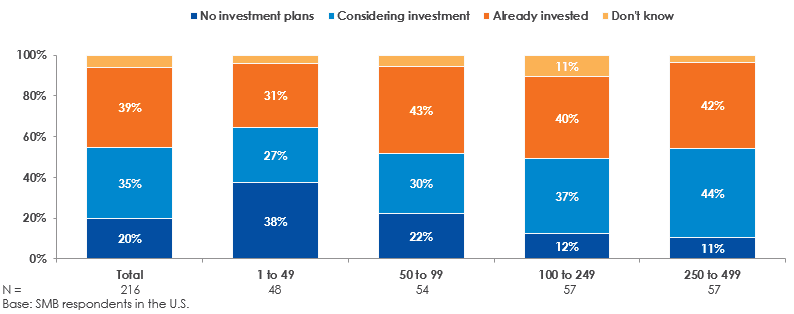All businesses have goals that are specific to their industry, region, and overall needs. That said, there are a number of unifying forces at play, driving corporate decision-making. One of these is the move toward document management.
Definition and adoption rates
Document management is defined as the coordination and control of the flow of digital and hardcopy documents in a secure and efficient manner. According to Keypoint Intelligence-InfoTrends research, close to 40% of U.S. businesses have already invested in document management software, and another 35% are considering investment in this area.
As shown in the chart below, businesses with 50 or more employees are most likely to have already adopted document management software; those with 100 or more employees are most likely to be considering it.
Figure 1: Are you considering purchasing document management software?
Source: Keypoint Intelligence-InfoTrends research
Factors driving move to document management
Both business software and the Internet have vastly increased the amount of data and information that businesses are accessing and using. With all of this information at their disposal, businesses have a greater need to manage it in an efficient way. Furthermore, the increased incidence of security breaches and cyber attacks within organizations has heightened the need to ensure that business content is adequately protected.
Key features of document management systems
Comprehensive document management systems encompass both digital and paper-based information. They include everything from secure and well-organized filing cabinets to searchable databases to access control. Below are other common components of electronic document management:
- Ability to attach metadata to files
- Automated input of data
- Optical character recognition for scanned input
- Ability to easily search for/find information
- Version control to ensure users working on latest version of document
- Ability to guarantee multiple versions of document not being edited simultaneously
- Clear identification of changes or edits
- Ability to track source of document and who has accessed it
- Document approval capability
- Document disposal for files no longer needed
- Ability to program time-saving workflows
- Connectivity with other systems
Factor to consider when considering document management technology
Companies interested in improving document management are encouraged to consider the balance of paper and digital files in their organization. Some companies are close to 100% digital, while others are quite paper-dependent. The average falls somewhere in between. Depending on an organization’s document mix, as well as its document priorities, it may make sense to focus on a certain aspect of document management over another—at least initially.
Resources for document management information
Organizations seeking more information on document management are encouraged to reach out to their business technology providers. They can help them determine which solutions might make sense for their particular needs. They may also be able to provide case studies that show how an organization within their sector or company size category used document management to improve business operations.
In some cases, upgrading devices like PCs, printers and copiers, and scanners might be an important step for an organization to improve the efficiency and security of its document workflows. In other instances, hiring a document specialist, or at least training employees on document management, may be a wise move. If your organization seeking more information on secure and efficient document management, feel free to contact our experts.
Original: October 4, 2018
Updated: March 30, 2022